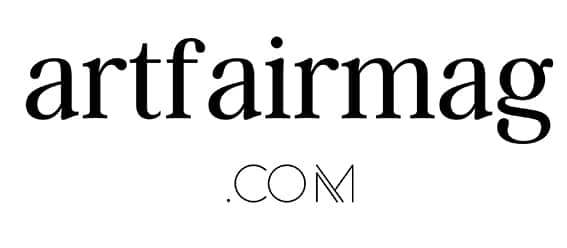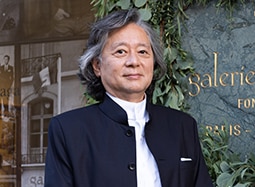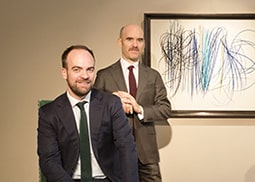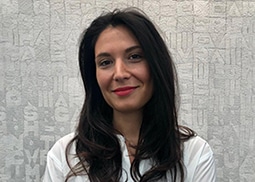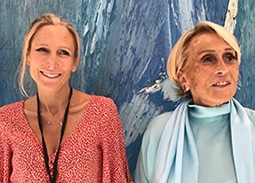Mazzoleni
Mazzoleni was founded in Turin in 1986 by Giovanni and Anna Pia Mazzoleni as a natural evolution of the private collection they started in the 1950s. Since 2014, the historic Turin space has been flanked by the London gallery in Mayfair. Over the past three decades Mazzoleni has organised solo and group exhibitions of more than 200 prominent Italian and international artists from across the 20th century with an exhibition programme focused on museum-calibre Italian art from the post-war period and recently also the contemporary panorama, working in close collaboration with artists’ estates and foundations. Mazzoleni is one of the 60 influential art galleries that are part of ITALICS, a consortium promoting Italian culture on an international scene.
Mazzoleni
Mazzoleni was founded in Turin in 1986 by Giovanni and Anna Pia Mazzoleni as a natural evolution of the private collection they started in the 1950s. Since 2014, the historic Turin space has been flanked by the London gallery in Mayfair. Over the past three decades Mazzoleni has organised solo and group exhibitions of more than 200 prominent Italian and international artists from across the 20th century with an exhibition programme focused on museum-calibre Italian art from the post-war period and recently also the contemporary panorama, working in close collaboration with artists’ estates and foundations. Mazzoleni is one of the 60 influential art galleries that are part of ITALICS, a consortium promoting Italian culture on an international scene.
Modern Art
15 Old Bond Street
London, W1S 4AX, UK
+44 20 7495 8805
london@mazzoleniart.com
Piazza Solferino, 2
10121 Torino, IT
+39 011 534473
torino@mazzoleniart.com
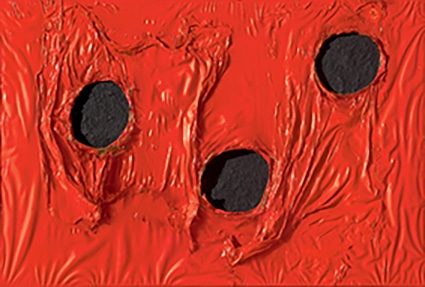
Alberto Burri
Rosso Plastica, 1968
Plastic, acrylic and combustion on Celotex
51 x 75 cm / 20 1/8 x 29 1/2 in
Courtesy Mazzoleni, London – Torino
All our Interviews

Read all our exclusive interviews with antique, modern, contemporary & primitive art dealers.

Interview with Luigi Mazzoleni
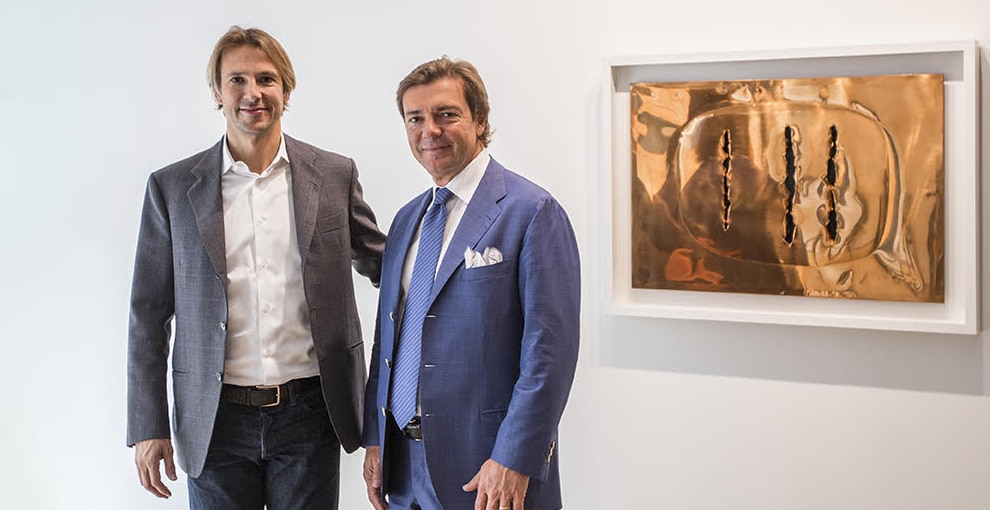
Luigi and Davide Mazzoleni. Courtesy Mazzoleni, London-Torino
Interview by Pauline Loeb-Obrenan, founder of artfairmag.
Under the leadership of Davide and Luigi Mazzoleni, the gallery has intensified its international activities, participating in numerous art fairs in Hong Kong, New York, Los Angeles, Miami, London, Paris, and Seoul. While Davide manages the Turin space, Luigi leads the London gallery. We spoke with him about his career, the gallery, the international fairs, and the current art market.
artfairmag: Luigi Mazzoleni, you joined the family business at the age of 27. Did you always know that you would work in the firm?
Luigi Mazzoleni: When you grow up in a family where you breathe art from an early age – as it was the case for me and my brother Davide – art becomes part of your DNA. Thanks to my father, who was our mentor, I learnt how to recognise the quality of artists and their works, but I also acquired a sense of respect towards the figure of the artist, the one who is brave enough to express themselves by putting their vision and sensitivity in an artwork.
artfairmag: In October 2014, the gallery expanded to London by opening a new space that you have been running ever since. How is the English art market different from the one in Turin?
L. M.: Since October 2014, London has proved to be a vital point, facilitating our connections with collectors from all over the world. In only a few years, thanks to a series of museum-calibre exhibitions dedicated to Italian art, we managed to access the international scene at a speed that only a city like London could offer. The London space operates in synchrony with the Turin gallery, sharing the core of our programme based on the great Italian masters, alongside contemporary and experimental tendencies, in a more international context. Certainly, the challenges faced by the two galleries differ: London represents an excellent platform to bring to the attention of the general public those Italian artists who have not received the right recognition just yet, or to provide a deep dive into the work of already known masters and their mutual connections, as we have done with the retrospectives on Bonalumi, Boetti, Burri or Manzoni, or with the exhibition dedicated to Fontana and Melotti; while in Turin there is a tendency to also offer an attentive look on the most recent contemporary productions. The Turin and London galleries jointly participate in international fairs, in New York, Miami, Hong Kong, Seoul, Los Angeles, with a symmetry in their programmes when possible.
artfairmag: Mazzoleni’s core specialty is Post-War Italian art but also arte povera. It is thanks to galleries like yours that this important avant-garde movement, represented by artists such as Alighero Boetti and Mario Merz, is increasingly known and appreciated by collectors. Can you explain your commitment to promoting this specific period and these artists?
L. M.: Initially, the gallery’s collection and exhibition programme were centred on the early 20th century; subsequently my brother and I focussed on the art produced during the Italian and international second post-war period until Arte Povera; following this research line, we re-encountered Analytical Painting of the 1970s, a movement that has been witnessing a successful rediscovery over the last few years. At the same time, a strong interest in the work of post-war masters – such as Bonalumi, Burri, Castellani, Manzoni, and Fontana – remains very strong. Most recently, we have dedicated an articulated programme of exhibitions and retrospectives that can satisfy the needs of our collectors; in some cases, we aimed at creating a dialogue between our masters and contemporary living artists, with exhibitions such as Neon in Contextual Play: Joseph Kosuth and Arte Povera (Mazzoleni Turin, 2017).
“The face-to-face confrontation with the production of an artist of Burri’s caliber […] was a unique and irreplaceable experience.”
artfairmag: In recent years, you have personally initiated an expansion into contemporary art. Why did you make this choice? Was it to target a younger audience?
L. M.: In recent years, the gallery has expanded its activity towards contemporary art. The purpose is to support artists who stand out for the peculiarity of their artistic research and practice, providing them with the necessary support and presenting the results of such creative processes to an increasingly diverse audience – this is the case of the fruitful collaboration with Marinella Senatore with her recent multi-site exhibition Afterglow in London.
artfairmag: Before the pandemic, Mazzoleni was participating in more and more international art fairs including Art Basel, Frieze, TEFAF, FIAC, among others. Has this long hiatus without any show brought out other sales channels that may lead you to reconsider their importance in your business model?
L. M.: Since the first lockdown we have applied a double approach on our digital channels: on the one hand, we created Online Viewing Rooms on our website – digital exhibitions that have partly reflected our physical programme; on the other hand, we have implemented some exclusive social media campaigns, keeping our work constantly active and accessible to the public. We participated in online fairs and appreciated that the digital cannot be considered a mere substitute of in-person events. When collecting modern art, the fruition of the work is essential. The digital world certainly offers possibilities, even if different in nature, with their own narrative languages and structures. Today we are better prepared on the digital side, but it was particularly stimulating to go back to a direct approach with the public and our collectors, having a different sensitivity and a renovated awareness.
artfairmag: I think we can say that the art market is almost back to normal. What lessons have you learned from this challenging period?
L. M.: In general, what we have observed after this atypical period is an interested but cautious type of collecting, perhaps due to the hopeful yet uncertain recovery after a long period of inactivity. During this moment of great political and social change, the market signals are various and delicate but not necessarily negative; on the contrary, we believe that even from the uncertainty caused by new international structures, interesting new opportunities might arise. The ability to adapt has been invaluable in identifying new paths and collaborations, transforming a moment of difficulty into a time of great growth opportunity.
artfairmag: To conclude this interview, could you present us a work of art that is special to you, and explain the reasons for this choice?
L. M.: During my first visit to the Palazzo Albizzini “Collezione Burri” Foundation in the late 1990s, I was mesmerised by the red plastic combustion Rosso Plastica: I was taken over by emotions I had never felt before in front of a work of art. The face-to-face confrontation with the production of an artist of Burri’s caliber – along with the plasticity and the traits that define his work between the limits and the subversive exploration of matter – was a unique and irreplaceable experience.
More Interviews
Galerie Taménaga
With one space in Paris and 3 spaces in Japan, Galerie Taménaga is a wonderful bridge between the two cultures since its opening in 1969.
Brame & Lorenceau
Tornabuoni Art
Created in 1981 by Roberto Casamonti, Tornabuoni Art has established itself as a leading gallery for Post-War Italian art, with artists as Burri, Fontana, Castellani and Boetti.
Galerie Berès
Founded more than 60 years ago, Galerie Berès focuses since the beginning on French painting of the avant-garde movements in 19th and 20th centuries, and on Japanese art.
